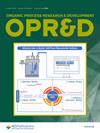An Alternate, Efficient Synthetic Process for a Hemolytic Anemia Drug: Mitapivat Sulfate
IF 3.1
3区 化学
Q2 CHEMISTRY, APPLIED
引用次数: 0
Abstract
A new commercial manufacturing process for producing mitapivat sulfate, crucial for treating hemolytic anemia, is described. Starting from 4-nitrobenzoic acid (14) and N-Boc piperazine (6), the process involves sequential reactions to obtain tert-butyl 4-[4-(quinoline-8-sulfonamido)benzoyl]piperazine-1-carboxylate (7). This compound is then deprotected to yield N-[4-(piperazine-1-carbonyl)phenyl]naphthalene-1-sulfonamide (8), which undergoes reductive amination to produce mitapivat-free base (9). Finally, mitapivat sulfate is obtained with high quality and an overall yield of 81%. The synthesis prevents impurity formation and employs cost-effective raw materials, adhering to environmental sustainability and ICH product quality standards.

溶血性贫血药物的另一种高效合成工艺:硫酸米他匹伐他
本文介绍了一种生产硫酸米他匹伐的新型商业生产工艺,该工艺对治疗溶血性贫血至关重要。从 4-硝基苯甲酸(14)和 N-叔丁氧羰基哌嗪(6)开始,该工艺通过连续反应获得 4-[4-(喹啉-8-磺酰胺基)苯甲酰基]哌嗪-1-甲酸叔丁酯(7)。然后对该化合物进行脱保护反应,得到 N-[4-(哌嗪-1-羰基)苯基]萘-1-磺酰胺(8),再对其进行还原胺化反应,得到无米他匹伐碱(9)。最后得到高质量的米他匹伐硫酸盐,总产率高达 81%。该合成方法避免了杂质的形成,并采用了具有成本效益的原材料,符合环境可持续性和 ICH 产品质量标准。
本文章由计算机程序翻译,如有差异,请以英文原文为准。
求助全文
约1分钟内获得全文
求助全文
来源期刊
CiteScore
6.90
自引率
14.70%
发文量
251
审稿时长
2 months
期刊介绍:
The journal Organic Process Research & Development serves as a communication tool between industrial chemists and chemists working in universities and research institutes. As such, it reports original work from the broad field of industrial process chemistry but also presents academic results that are relevant, or potentially relevant, to industrial applications. Process chemistry is the science that enables the safe, environmentally benign and ultimately economical manufacturing of organic compounds that are required in larger amounts to help address the needs of society. Consequently, the Journal encompasses every aspect of organic chemistry, including all aspects of catalysis, synthetic methodology development and synthetic strategy exploration, but also includes aspects from analytical and solid-state chemistry and chemical engineering, such as work-up tools,process safety, or flow-chemistry. The goal of development and optimization of chemical reactions and processes is their transfer to a larger scale; original work describing such studies and the actual implementation on scale is highly relevant to the journal. However, studies on new developments from either industry, research institutes or academia that have not yet been demonstrated on scale, but where an industrial utility can be expected and where the study has addressed important prerequisites for a scale-up and has given confidence into the reliability and practicality of the chemistry, also serve the mission of OPR&D as a communication tool between the different contributors to the field.

 求助内容:
求助内容: 应助结果提醒方式:
应助结果提醒方式:


